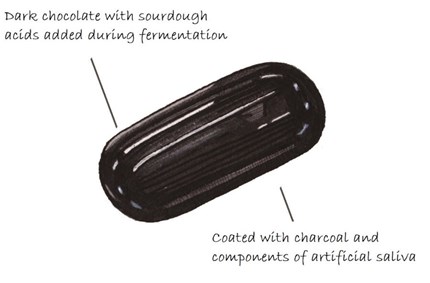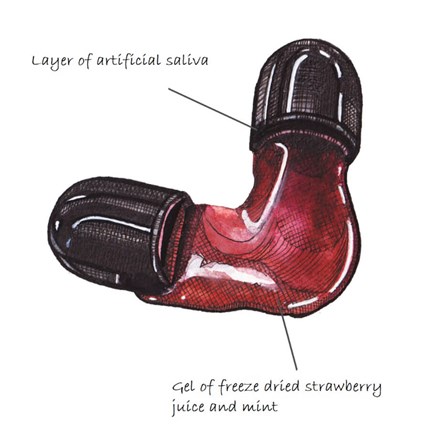When The Chocolate Line in Bruges, Belgium, was approached by the charity, Shout at Cancer, there was always going to be something very special and innovative in the pipeline! Shout at Cancer’s Thomas Moors has been chatting with Julius Persoone, Director of Research and Development for The Chocolate Line, about the design and development of chocolates for the laryngectomee community.
Shout at Cancer uses singing, acting, and beatboxing techniques to improve speech after laryngectomy. With our choir activities, we aim to inspire the laryngectomy community and inform a broader audience about the layered psychosocial impact of this life-changing operation. Our concerts and activities are a form of storytelling to engage with audiences from very different fields: arts, science, technology, and healthcare specialists.
Since setting up our foundation five years ago, we have received prestigious prizes and grants, had worldwide media coverage (including a feature documentary, Can You Hear My Voice? by director Bill Brummel), performed at renowned art venues, and spoken at highly regarded scientific conferences. Our unique approach has inspired research and art, and increased awareness of a small, scattered, and easily overlooked group: the laryngectomy community.
Our attention during our first years of activity was predominantly focused on improving speech and overcoming social isolation. We have invested heavily in representation of the laryngectomy voice in the public domain and it is now time to highlight different aspects of the impact of laryngectomy. We are therefore adding a new direction to our scope of activities in our strategy for the next five years: devoting more attention to the experience of food and eating after laryngectomy.
To mark the start of this new route, we’ve interviewed Julius Persoone, Director of Research and Development for The Chocolate Line in Bruges, Belgium, to discuss the product of their recent collaboration with Foodpairing and Shout at Cancer: mouth-watering chocolates.
Can you tell us more about how this collaboration came about?
We are one of the leading names in the world of chocolate design and its applied science and technology. That is why we were approached by Shout at Cancer and challenged to design a chocolate for the laryngectomy community. When we heard about how the operation affects swallow and taste and that chocolates are hard for them to eat, we knew that, as Belgians, we could not stand idle - something had to be done about this!
It sounds complicated to design a chocolate for such a specific target group, with quite unusual changes and limitations in their food experience. How did you find out the relevant information?
We were fortunate to have great support from experts in the fields. Dr Moors explained to us in great detail what laryngectomy is and how complex the consequences are. We were provided with a great deal of literature on the research into the effects on taste and saliva production after laryngectomy and (chemo)radiotherapy.
That gave us good insight into what to focus on; we then explored in more detail how taste, mouth experience, and swallow are changed, by sending out a survey that was completed by more than 220 laryngectomy participants (we thank NALC and Atos Medical for their help in reaching such a large number!). The survey was designed by Bernard Lahousse* from Foodpairing; world experts in mapping out food identity and preferences.
The outcome of this survey showed a shift towards a palate more based on the basic tongue tastes. There was also a change in preferences, with a stronger leaning towards sour and sweet tastes over salty and bitter as the least favourite. There was a preference for berry and mint flavours and a strong predilection for smooth food textures.

Let me get this right for the readers: The outcome of the survey asked you to develop a smooth, sour, berry, and minty chocolate. You were given the instruction to avoid the bitterness of cacao, which is the base and biggest component of quality chocolates. That sounds an almost impossible task. Were you able to find a solution?
For the base, we used a new type of dark chocolate, by Belcolade. It’s special because, during the fermentation process, they added acids that are used in sourdough bread. It gives it a more tangy, still mild, characterful flavour and is less bitter. We chose that because it's tailored to their new taste palate and because the extra acidity encourages saliva production.
You decided to flavour the chocolates with strawberries and mint, combining hints of traditional English favourites like strawberries and After Eight chocolates. Were there special techniques used to give the chocolates this flavour?
We made a gel of strawberry juice and added mint powder to give it a refreshing feel. We used a vacuum drying machine to intensify the colours and taste and transformed it into a velvety smooth liquid gel. This is an important contribution to the mouth experience for laryngectomees, who often have had radiotherapy or have a dry mouth.

Good point, swallowing is indeed more difficult after laryngectomy and often gulps of water or extra gravy and sauce are used during meals to make it easier. However, in this case, it would be a waste to not be able to savour the experience of a nice chocolate in your mouth. How did you manage to overcome this problem?
We introduced an additional layer of artificial saliva in the chocolates. When you bite into the chocolate, it’s released and mixed with the chocolate and the filling. Adding artificial saliva makes chewing easier, improves the taste experience, prevents them from sticking to the roof of the mouth, and helps with swallowing. This way, we were able to offer something nice to bite into, something crunchy, that turns smooth in the mouth. Using artificial saliva did add a lot of layers of difficulties to overcome to get this right.
I don't know much about chocolates, but isn’t it a bold idea to add a liquid, and not just any liquid, but saliva, to a chocolate?
Yeah, very tricky - saliva is made of enzymes, proteins and salts, etc. We had to spray an extra protective layer of hydrophobic coconut oil to prevent the saliva from mixing with the rest, otherwise it would start breaking down the chocolates!
One downside is that the shelf life is limited, and transport is risky business! Our first experiment showed that it is possible, although we need further research and development before we can produce something on a large scale.
Sounds like the start of an interesting journey you have embarked on with Shout at Cancer, although a difficult start in terms of the complexity of this experiment. Is there perhaps a funny story or reflection you want to share?
Haha, yes - there were many times when I thought, what did I get myself into?! Especially in the beginning, when I mixed it all together agar, citrus and saliva: It turned into a huge snot. Didn't look tasty at all!
The proposed idea of adding artificial saliva to the chocolates was already met with lots of ‘ewww’ reactions, so making it look like snot was definitely a no-no.
That would have been hard to swallow indeed! On that note, you designed the chocolate in the shape of medication. What was the idea behind that?
Improving quality of life is often overlooked in medicine. To make the point that ‘bitter pills should be made easier to swallow’, we have designed the chocolates in the shape of a pill. Paying more attention to the small things can create joy. Simple things that can be shared with family and friends are a huge support for people going through difficult times because of health issues, and yes, that support can also be a form of medication.
That’s a very mindful and poetic extra layer you managed to give to mouth-watering chocolates! The chocolates are still in the process of research and development, but this is exciting progress to share. Thanks for devoting your passion and expertise to helping improve the quality of life after laryngectomy.
*Bernard Lahousse, Foodpairing. www.foodpairing.com
Illustrator: Claire Holmes. https://claireholmesillustration.com/





